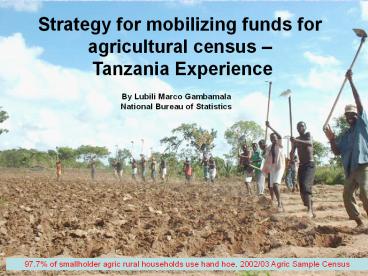WELCOME TO GENDER DISAGGREGATED DATA - PowerPoint PPT Presentation
Title:
WELCOME TO GENDER DISAGGREGATED DATA
Description:
... sample survey with district estimates is desirable than the one with ... of the users of the survey results and during the dissemination process to find ... – PowerPoint PPT presentation
Number of Views:912
Avg rating:3.0/5.0
Title: WELCOME TO GENDER DISAGGREGATED DATA
1
Strategy for mobilizing funds for agricultural
census Tanzania Experience
By Lubili Marco Gambamala National Bureau of
Statistics
97.7 of smallholder agric rural households use
hand hoe, 2002/03 Agric Sample Census
2
- Contents
- Background
- Why conduct Agriculture Surveys and Censuses?
Regional Estimates Vs District Estimates - Soliciting Funds for Agriculture Surveys and
Censuses? - User Producer Dialogues
- Dissemination Workshops
- Timely Production of Reports and quality
statistics - Methodology used to collect the information
- Adoption and use of new and modern technologies
- Conclusion and Recommendations
3
1. Introduction
- Most developing countries have recently expressed
their commitment to their countries economic
reforms. - laying out strategies aiming at reduction of
poverty and creation of wealth - Managing their economic reforms in partnership
with development agencies, because of lack of
resources - In Tanzania, agriculture plays a significant role
in employment as well as in wealth creation - Agriculture sector development be given a
foremost important priority by developing
countries in terms of development, resource
allocation, planning and measurement of outcomes.
- In Tanzania a vision 2025 Poverty Monitoring
Master Plan strategy has been formulated. - planned a series of censuses and surveys to
assist in policy formulation, planning and to
track changes
4
2. Why conduct Agriculture Surveys and Censuses?
Regional Estimates Vs District Estimates
- In Tanzania and most developing countries a
sample survey with regional estimate is cheaper
to undertake than a Sample Survey with District
estimates, the following reasons justifies why a
sample survey with district estimates is
desirable than the one with regional estimates - .
- Local Government Reform Programs, government
decentralization Program, the ASDP Need for
timely, reliable and regular Statistics - due to the requirement of district estimates and
the need for a wider dataset the cost of these
surveys became too much to conduct annually,
decided to carry out a comprehensive Agriculture
Survey every 5 years instead.
5
2. Soliciting Funds for Agriculture Surveys and
Censuses?
- It is important to note that surveys and census
in particular are resource intensive and most
developing countries cannot fund these exercises
from their own resources. In Tanzania
particularly funding for Agriculture Surveys and
Censuses has been through the poverty monitoring
master plan, a program which draws funds from
development partners and the Government. Below
are the strategies used to solicit funds for
Agriculture Surveys.
User Producer Dialogue In Tanzania these
dialogues are normally done during the initial
planning stage of Agriculture Surveys/Census to
understand the actual requirement of the users of
the survey results and during the dissemination
process to find out whether the requested demands
have been addressed adequately.
6
Dissemination Workshops In Tanzania Dissemination
workshops are done to inform the Government,
donor community, development partners and the
General Public of the results obtained from
Agriculture Surveys and Censuses. This is a
feedback mechanism and tries to inform
specifically the donors about the results
obtained from the exercise.
Timely Production of Reports and quality
statistics It is very important to timely produce
the intended set of reports so that users could
utilize the information timely and efficiently.
This increases the confidence of the users to the
producers and this is likely to attract the
willingness of the policy makers (users) to
provide funds for Agriculture Surveys and
Censuses.
7
- Methodology used to collect the information
- The methodology used to undertake Agriculture
Surveys and Censuses in Tanzania is a subjective
method. - That is carrying out direct interviews with
respondents in order to complete the survey
questionnaires. - In early 90s Tanzania used to carry out
Agriculture Surveys and Censuses by using the
Objective measurement method. - But later a study which was conducted by
experienced Agricultural Statisticians
recommended that subjective survey method was
cheaper in terms of cost and easy to manage than
objective survey method. - Since then Tanzania adopted the subjective method
and it has proved to produce reliable, timely and
cost effective results than objective measurement.
8
- Adoption and use of new and modern technologies
- The 2002/03 Tanzania Agriculture Census used OCR
Scanning technology for capturing the data from
the questionnaires . - The same technology has been used for the 2007/8
Agriculture Sample Census. - This technology is cheaper and has minimum data
capture errors compared to manual Data entry. - Use of this technology also helps to reduce the
Agriculture Sample Census budget estimates and
therefore make the funding exercise affordable to
Donors.
9
- Conclusion and Recommendation
- The design of a poverty monitoring master plan
should set coherent work programme , making sure
that costing of the programme is done properly
and ensuring sufficient funds for agriculture
surveys. - Country level producer user dialogue be
encourages as a feedback mechanism to the users
and donors - Countries should adopt the use of cost effective
data collection and processing methodologies - Data Producers should develop the spirit of
timely production of Agriculture Census reports,
10
THANK YOU FOR YOUR ATTENTION































